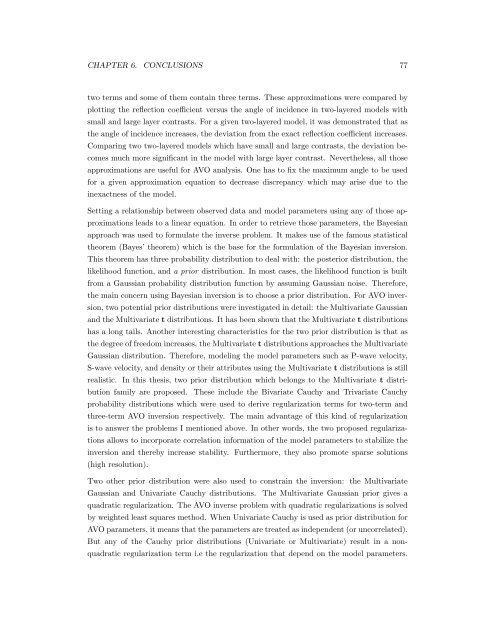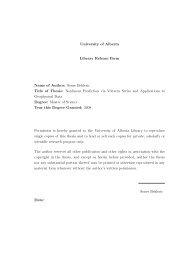Regularization of the AVO inverse problem by means of a ...
Regularization of the AVO inverse problem by means of a ...
Regularization of the AVO inverse problem by means of a ...
You also want an ePaper? Increase the reach of your titles
YUMPU automatically turns print PDFs into web optimized ePapers that Google loves.
CHAPTER 6. CONCLUSIONS 77<br />
two terms and some <strong>of</strong> <strong>the</strong>m contain three terms. These approximations were compared <strong>by</strong><br />
plotting <strong>the</strong> reflection coefficient versus <strong>the</strong> angle <strong>of</strong> incidence in two-layered models with<br />
small and large layer contrasts. For a given two-layered model, it was demonstrated that as<br />
<strong>the</strong> angle <strong>of</strong> incidence increases, <strong>the</strong> deviation from <strong>the</strong> exact reflection coefficient increases.<br />
Comparing two two-layered models which have small and large contrasts, <strong>the</strong> deviation be-<br />
comes much more significant in <strong>the</strong> model with large layer contrast. Never<strong>the</strong>less, all those<br />
approximations are useful for <strong>AVO</strong> analysis. One has to fix <strong>the</strong> maximum angle to be used<br />
for a given approximation equation to decrease discrepancy which may arise due to <strong>the</strong><br />
inexactness <strong>of</strong> <strong>the</strong> model.<br />
Setting a relationship between observed data and model parameters using any <strong>of</strong> those ap-<br />
proximations leads to a linear equation. In order to retrieve those parameters, <strong>the</strong> Bayesian<br />
approach was used to formulate <strong>the</strong> <strong>inverse</strong> <strong>problem</strong>. It makes use <strong>of</strong> <strong>the</strong> famous statistical<br />
<strong>the</strong>orem (Bayes’ <strong>the</strong>orem) which is <strong>the</strong> base for <strong>the</strong> formulation <strong>of</strong> <strong>the</strong> Bayesian inversion.<br />
This <strong>the</strong>orem has three probability distribution to deal with: <strong>the</strong> posterior distribution, <strong>the</strong><br />
likelihood function, and a prior distribution. In most cases, <strong>the</strong> likelihood function is built<br />
from a Gaussian probability distribution function <strong>by</strong> assuming Gaussian noise. Therefore,<br />
<strong>the</strong> main concern using Bayesian inversion is to choose a prior distribution. For <strong>AVO</strong> inver-<br />
sion, two potential prior distributions were investigated in detail: <strong>the</strong> Multivariate Gaussian<br />
and <strong>the</strong> Multivariate t distributions. It has been shown that <strong>the</strong> Multivariate t distributions<br />
has a long tails. Ano<strong>the</strong>r interesting characteristics for <strong>the</strong> two prior distribution is that as<br />
<strong>the</strong> degree <strong>of</strong> freedom increases, <strong>the</strong> Multivariate t distributions approaches <strong>the</strong> Multivariate<br />
Gaussian distribution. Therefore, modeling <strong>the</strong> model parameters such as P-wave velocity,<br />
S-wave velocity, and density or <strong>the</strong>ir attributes using <strong>the</strong> Multivariate t distributions is still<br />
realistic. In this <strong>the</strong>sis, two prior distribution which belongs to <strong>the</strong> Multivariate t distri-<br />
bution family are proposed. These include <strong>the</strong> Bivariate Cauchy and Trivariate Cauchy<br />
probability distributions which were used to derive regularization terms for two-term and<br />
three-term <strong>AVO</strong> inversion respectively. The main advantage <strong>of</strong> this kind <strong>of</strong> regularization<br />
is to answer <strong>the</strong> <strong>problem</strong>s I mentioned above. In o<strong>the</strong>r words, <strong>the</strong> two proposed regulariza-<br />
tions allows to incorporate correlation information <strong>of</strong> <strong>the</strong> model parameters to stabilize <strong>the</strong><br />
inversion and <strong>the</strong>re<strong>by</strong> increase stability. Fur<strong>the</strong>rmore, <strong>the</strong>y also promote sparse solutions<br />
(high resolution).<br />
Two o<strong>the</strong>r prior distribution were also used to constrain <strong>the</strong> inversion: <strong>the</strong> Multivariate<br />
Gaussian and Univariate Cauchy distributions. The Multivariate Gaussian prior gives a<br />
quadratic regularization. The <strong>AVO</strong> <strong>inverse</strong> <strong>problem</strong> with quadratic regularizations is solved<br />
<strong>by</strong> weighted least squares method. When Univariate Cauchy is used as prior distribution for<br />
<strong>AVO</strong> parameters, it <strong>means</strong> that <strong>the</strong> parameters are treated as independent (or uncorrelated).<br />
But any <strong>of</strong> <strong>the</strong> Cauchy prior distributions (Univariate or Multivariate) result in a non-<br />
quadratic regularization term i.e <strong>the</strong> regularization that depend on <strong>the</strong> model parameters.









